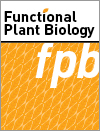During drought, plants experience impairements in water transport due to the enter of air bubbles in the lumen of water-transporting xylem cells. Here, we review the optical vulnerability (OV) technique – a recently developed method allowing direct quantification of xylem embolism across plant organs with high spatial and temporal resolution. This method has been widely utilised by the broad pant science community since its development in 2016, allowing us to better understand plant hydraulic function during drought.
FP21326 Abstract | FP21326 Full Text | FP21326PDF (3.4 MB) | FP21326Supplementary Material (303 KB) Open Access Article





